Synagogues in Spain
A few weeks ago we stayed at a hotel in Seville, Spain called Las Casas de la Juderia, literally the houses of the Jewish Quarter. It was beautiful, right next to an old church called Santa Maria la Blanca that was in medieval times a synagogue. We had a terrace that overlooked the old church and the early morning air was filled with doves cooing.
It turns out that the history of Seville and the Jews was not as pleasant. Jews had lived in Seville for hundreds of years, first under the Christian Visigoths during the 5th and 6th centuries, then under the Moors from 712 until it was reconquered by the Christian king Fernando III of Castile in 1248. Despite occasional persecution Jews prospered under Christian and Muslim alike. The ancestors of Isaac Abrabanel made Seville their home. In 1391 tragedy struck as an anti-Semitic priest, Don Fernando Martinez, began to incite the common people against the Jews, first looting the Jewish quarter and then returning on July 6, 1391 to slaughter the Jews: “men, women and children had their throats slit without mercy, in their own homes, and in the synagogues. The massacre lasted an entire day and cost the lives of…4000 souls.” In spite of the imprisonment of those responsible and a punitive fine on the city of Seville, the Jewish community never recovered, the three synagogues were expropriated and when the Decree of Expulsion in 1483 was proclaimed there were almost no Jews left to kick out.
Suddenly the mournful cooing of the doves sounded like the last echoes of the Jews murdered so long ago. I realized I had come to a place a tragedy, a Spanish holocaust that culminated in the mass expulsion of the Jews in 1492. But as I was to learn, the history is considerably more complex.
There are only three medieval synagogues that survive in Spain. Two in Toledo and one in Cordoba. There were hundreds before 1492. Each of these was subsequently used as a church, a hospital, a storehouse, a school and, finally now, turned into museums. The destruction of Spanish Jewry is etched in these buildings, a silent testament to Islamic and Christian power and religious cruelty.
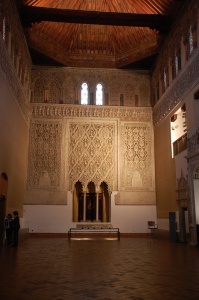
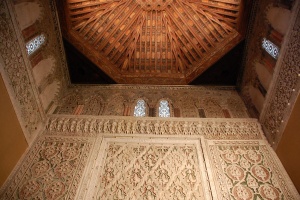
Of the synagogues in Toledo, El Transito, is the most impressive and consequently the most moving. It was built by Samuel haLevi Abulafia, famous financier and councilor to the king of Castile, in 1357. One is immediately awed entering the main sanctuary, knowing that its 30’ high walls were originally completely covered with stucco filigree decoration. It can accommodate at least 100 congregants (an unobstructed rectangle 78′ by 32′) while the upstairs has room for about 50 seats for the women who can overlook everything that transpires downstairs. Natural light is provided by six windows on the Western wall and the high clerestory windows placed between the 54 arches that surround the space 35′ above the floor.
The wall decoration, painstakingly hand-carved in plaster in the mudejar style that applied Islamic decorative elements to Christian and Jewish architecture (1300-1600, Southern Spain), creates a low relief that animates the vertical wall surfaces with constantly shifting visual interest depending upon the light at different times of the day. Unfortunately only the eastern wall decoration and uppermost registers all around have survived the ravages of time and persecution.
Confronted by the overwhelmingly Islamic nature of the decoration one is startled by the bold inclusion of Hebrew text running along the top of all the walls and framing all of the decorative panels. One catches snatches of Psalms and other dedicatory panels in Hebrew lauding Samuel haLevi, the architect Rabbi Don Mayer, and the local community for building this edifice under the beneficent protection of King Don Pedro also represented by the coat of arms of Castile and Leon. Clearly this community was comfortable with and at peace with their Christian neighbors and rulers. At least they were then.
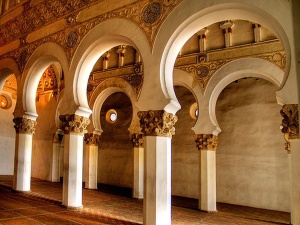
Three masterful panels that crown the three delicate arches of the Torah niche dominate the eastern wall. On either side a curvilinear pattern frames twelve plaques set against a pale green background. The entire panel is framed with a twisted vine floral motif and a Hebrew inscription from the Book of Psalms. Above the Torah niche a diagonal grid of decoration lends a kind of order to the Aron haKodesh. High above the massive sanctuary we see an elaborate inlaid cedar-wood ceiling.
Alone I davened mincha against the Eastern wall and cried at the tremendous loss. After a brilliant and successful life at the royal Spanish court, Samuel haLevi was caught up in palace intrigue and died under torture in Seville in 1360. Less than 150 years after this sanctuary was dedicated Ferdinand and Isabella ordered the expulsion of all Jews from the Iberian Peninsula.
Only a few blocks away in Toledo stands Santa Maria La Blanca, formerly an ornate synagogue commissioned by Joseph abu Omar ibn Shoshan, adviser to Alfonso VIII, around the year 1200. It represents a distinctly different and earlier approach to the mudejar style, following a mosque model, characterized by its 32 pillars that delineate a nave and four aisles. The presence of the three levels of horseshoe arches and lush interior make it an equally ornate, but still a distinctly segmented sanctuary.
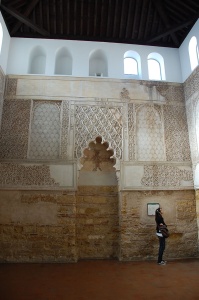
Perhaps since this synagogue was built on a mosque plan forever linking that sensibility and was used as church after 1411, again after anti-Semetic rantings of another priest, Friar Vincente Ferrer, it feels less Jewish but still as tragic as El Transito.
Finally, there is Cordoba: birthplace of the Rambam and center of Jewish learning and culture during the independent Caliphate of Cordoba, close to 200 years of freedom and culture. All that is left is a much more modest sanctuary, the Simon Majeb synagogue built in 1315. It is a small elegant room lit on three sides with high clerestory windows that can accommodate 40 worshipers at most with a small women’s section upstairs and, rather remarkably, much of its mudejar stucco decoration has survived. It is a diminutive gem, albeit filled with tears.
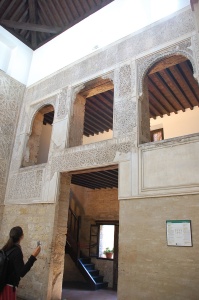
There were attacks in the now familiar disturbances of 1391 and finally in 1492 it too was liquidated and sold to non-Jews to be used as a rabies hospital, a shoemakers guild and a primary school. Forgotten until 1885 when its modern restoration began, it was reopened as a museum on the occasion of the 850th anniversary of the Rambam’s birth in 1985. The irony of course is that he was forced to flee Cordoba at the age of 15 when Islamic fundamentalists made life there impossible for Jews.
The cooing doves were in Seville where there were no synagogues left. In Toledo and Cordoba there were remnants, hints at the richness of Jewish life and achievement. It was deeply sad. And yet I felt with pride that these same Jews would affirm their faith in these very same halls twice a day, intoning not only “Shema Yisroel” but the much more difficult verse from Psalm 145; “You open Your hand and satisfy the desire of every living thing.” I only hope that if I am so challenged I will have the courage and faith of those Spanish Jews.
1 Comments
Donalda Curry
I have been to all three of these beautiful buildings and shall be visiting again later this year. Such a sad atmosphere remains after all these years. May the world never again see such hatred against any faith.